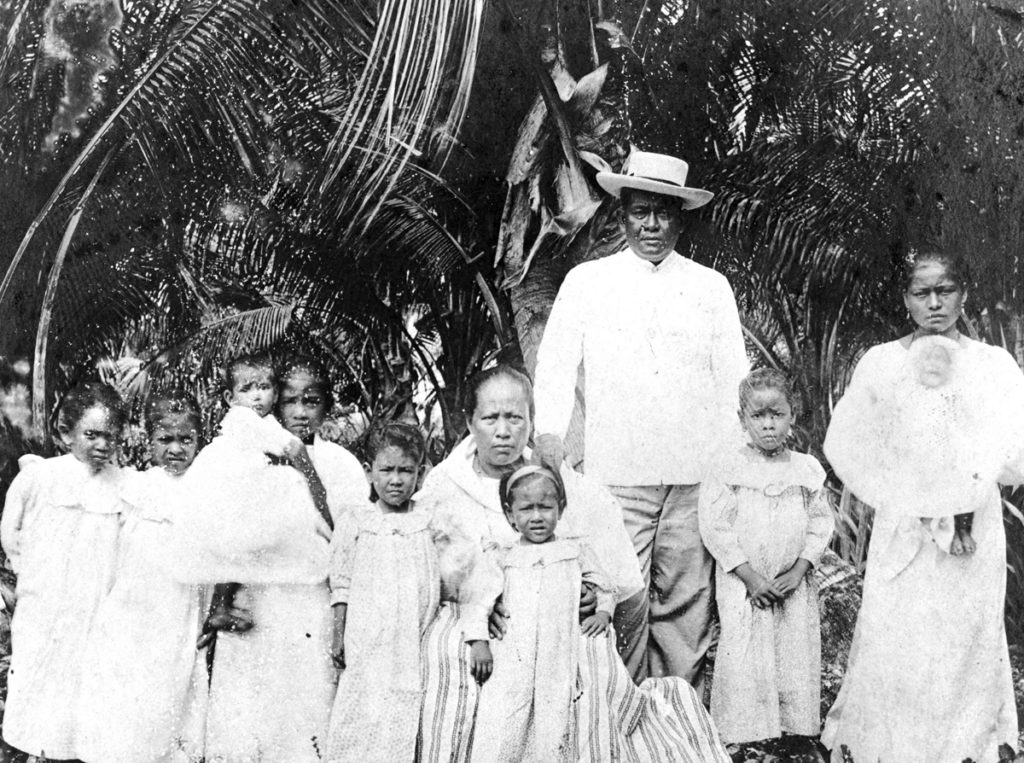
The “Better Known As” system
CHamorus have developed a way of identifying people other than their given names. Whether this “better known as” system came about because it was difficult to keep track of people due to many people having the same saint’s names, or from old clan names, can only be speculated upon.
The following “better known as” names are placed in categories according to various references.
References to the derivative of first names
- Eka derived from Rebecca/Blas
- ‘Ela derived from Manuela/Pangelinan
- Dero derived from Desidero/Blaz
- Ginya derived from Juana/Perez
- Chedu’ derived from Pedro/Benavente
- Api’ derived from Rafael/Pangelinan
- Lafit derived from Rafael/Borja
- Idu’ derived from Eduviges/Martinez
- Kaila derived from Micaila/Duenas
- Atdut derived from Salvador/Lujan
- Te’ derived from Jose/Sablan
- Sauru derived from Rosauro/Cruz
- Goyu derived from Gregorio/Perez
- Binu’ derived from Balvino/Leon Guerrero
- Sinda derived from Redocinda/ Eustaquio
- Ingu’ derived from Domingo/Cruz
- Nandu derived from Fernando/Peredo
- Gabit derived from Gabriel/Pereda
- Bete derived from Sylvestre/Palomo
References to the derivative of surnames
- Kottis derived from Cortez/Torres
- Teyu derived from Tello
- Desa derived from Deza/Camacho
- Safra derived from Zafra
- Robat derived from Roberts/Roberto
References to place names
- Manila/de la Torre
- Sambaguenu derived from Zamboanga/Borja
- Humåtak derived from Humåtak/Garrido
- Dadi/Santos
- Adiluk/Salas
References to animals
- Karabau/Carabao refers to Champaco or Quitigua
- Nganga’/Duck refers to Rosario or Santos
- Manuk/Chicken refers to Santos
- Lalu’/Fly refers to Rivera/Rosario
- Alimasak/Crab refers to San Nicolas
- Balaku/Boar refers to Ada
- Binado/Deer refers to Gumataotao
- Kichu/Fish refers to Lizama
- Chaka/Rat refers to Aguon
- Ga’lagu/Dog refers to Lizama
- Atu’/Swamp fish refers to Guzman
References to objects
- Pistola/Pistol refers to Guzman
- Ganggochi/Gunny Sack refers to Cruz
- Galaidi’/Canoe refers to Sablan
- Apu/Ashes refers to Flores
- Bibik/Whistle refers to Santos
- Bakalu/Crutch refers to Torres
- Tali/Rope refers to Santos
References to descriptive actions or quality
- Potput/Swollen refers to Mendiola
- Pinalala/Press for time refers to Flores
- Chetun/Stuck refers to Santos
- Minikus/Mucus-filled refers to Santos
- Lodu/Chubby refers to Castro
- Tugung/Charge forward refers to Blas
- Bodik/Lytico refers to Ada
- Mafongfung/To be pounded refers to Manibusan
- Makaka/Itchy refers to Aguon
- Anaku/Elongated refers to Cruz
- Chungi/Gray hair or white refers to Fernandez
- Manaitai/To pray or to read refers to Santos
- Bachit/Blind refers to Pangelinan
- Agaga’/Red refers to Cruz
- Basnak/To fall down or stumble refers to Gumataotao
- Buchi/Swollen neck refers to Cepeda
- Kadada/Short refers to Castro
- Kohu/Limping refers to Taitano or Mendiola
- Gutus/To split off refers to Mendiola
- Lachi/At fault refers to Aguon
- Badu/Hunchback refers to de Leon
- Yomuk/Fat, obese refers to Leon Guerrero
References to food
- Titiyas/Tortillas refers to Quinata
- Sibollas/Onions refers to Rosario
- Kamachili refers to Arceo
- Chada/Eggs refers to Cruz
- Dagu/Wild yam refers to Flores Gadu’
- Doni’/Pepper refers to Pereda
- Fadang/Federico palm refers to Crisostomo
- Poto/Rice desert refers to Palomo
- Tuba/Liquor from coconut refers to Guerrero
Other references to status, body parts, and other categories
- Kabesa/Leader refers to Flores
- Alkatdi/Mayor refers to Camacho
- Bobu/Spring refers to Benavente
- Gualafun/Full moon refers to Chargualaf
- Gugat/Muscle refers to Santos
Note from the author
Oral information is essential to the study of CHamoru genealogy. It is extremely vital that a researcher attempts to acquire the knowledge of informed elders for family genealogies. I was fortunate to have the cooperation of my own elders.
There was, however, one problem that I encountered from the information that I solicited. I am of the post-war generation of CHamorus. Traditionally CHamorus did not have a surname. Upon the arrival of the Spaniards and through the introduction of religion and civil government, surnames were assigned to each individual. Even with the introduction of the surname system for the purposes of documentation, the CHamoru families never fully adopted the system.
It was accepted, but never practiced, to address commonly the various family lineages. Even today most CHamoru families are known primarily by their unofficial family clan references. As a result, most CHamoru families have adopted a reference of the “better-known-as” system. It is important to have knowledge of these family clan references especially in obtaining genealogical information from recognized informants. There were several occasions when the informant only knew the individual according to his clan reference. I often had to resort to other informants to acquire the surname.
Again, I am of the post-war generation of CHamorus. Although I learned of certain family clan references, I was not knowledgeable of the majority of family nicknames.
To illustrate this system take the CHamoru family surname Sablan. There are several branches of the Sablans today that are referred to as “Ramases de “Te’,” “Deda’,” “Katingting,” “Dongga,” and “Teleforo.” These references are applied to the person’s first name. If there are four Juans in each branch, each will be addressed as “Juan Te’,” “Juan Deda’,” “Juan Katingting,” and “Juan Donggat.”
The “better known as” system is still widely used in the CHamoru society especially in the obituary announcements and political advertisements. There are various categories that designate each family according to either the surnames, derivative of first names, actions, objects, status, occupation, and names of animals or plants. Several references are so descriptive and humorous that oftentimes the present generation despises the descriptive attributes.
I collected a few of these “better-known-as” attributes with the assistance of my father, and my generous friend, Pedro Diaz Perez of the Ramas de Gollo family. Since this was written before there was an official orthography in CHamoru I resorted to my own intuition of the phonology and symbol correspondences of the CHamoru language.
By Anthony “Malia” Ramirez
Editor’s note: Originally written for the Liberation Day booklet on the 40th Anniversary of the Liberation of Guam.
